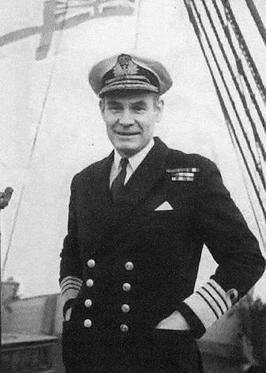
The Naval Intelligence Division (NID) was created as a component part of the Admiralty War Staff in 1912. It was the intelligence arm of the British Admiralty before the establishment of a unified Defence Intelligence Staff in 1964. It dealt with matters concerning British naval plans, with the collection of naval intelligence. It was also known as "Room 39", after its room number at the Admiralty.

The post of Controller of the Navy was originally created in 1859 when the Surveyor of the Navy's title changed to Controller of the Navy. In 1869 the controller's office was abolished and its duties were assumed by that of the Third Naval Lord whose title then changed to Third Naval Lord and Controller of the Navy. In 1904 the title was changed again to Third Sea Lord and Controller of the Navy. In 1965 the office of the Third Sea Lord was abolished. The post-holder is responsible for procurement and matériel in the British Royal Navy.

Admiral of the Fleet Terence Thornton Lewin, Baron Lewin, was a Royal Navy officer. He served in the Second World War and then commanded a destroyer, the Royal yacht, two frigates and an aircraft carrier before achieving higher command. He was First Sea Lord and Chief of the Naval Staff in the late 1970s and in that role he worked hard to secure a decent wage for servicemen and helped win them a 32% pay rise. He went on to be Chief of the Defence Staff during the Falklands War, serving as chief war planner and as Prime Minister Margaret Thatcher's chief advisor during the war. He was also the first Chief of Defence Staff to act as head of the Armed Forces rather than just Chairman of the Chiefs of Staff Committee.

The Fifth Sea Lord was formerly one of the Naval Lords and members of the Board of Admiralty that controlled the Royal Navy. The post's incumbent had responsibility for naval aviation.

The Commander-in-Chief, The Nore, was an operational commander of the Royal Navy. His subordinate units, establishments, and staff were sometimes informally known as the Nore Station or Nore Command. The Nore is a sandbank at the mouth of the Thames Estuary and River Medway. In due course the Commander-in-Chief became responsible for sub-commands at Chatham, London, Sheerness, Harwich and the Humber.
Rear-Admiral Loben Edward Harold Maund was a rear admiral of the British Royal Navy, who served in World War I and World War II. He was the captain of the aircraft carrier Ark Royal when she was sunk in November 1941, but went on to serve in Combined Operations, playing an important role in the development of landing craft.

The Assistant Chief of the Naval Staff (A.C.N.S.) is a senior appointment in the Royal Navy usually a two-star rank and has a NATO ranking code of OF-7.

Commodore Submarine Service is a post in the Royal Navy which involves command of the Royal Navy Submarine Service. It evolved from the post of Inspecting Captain of Submarines in 1901 and would later evolve to become the post of Flag Officer Submarines in 1944.
The Commander in Chief, Dover was an operational commander of the Royal Navy. His subordinate units, establishments, and staff were sometimes informally known as the Dover Command.

The Operations Division was a former directorate of the Admiralty Naval Staff responsible for the creation and implementation of long-term policy in regards to the composition of all Royal Navy fleets, squadrons and commands and including operational planning and monitoring from 1912 to 1961.

The Training and Staff Duties Division and later known as the Tactical and Staff Duties Division was a directorate of the Admiralty Naval Staff of the Royal Navy responsible for the tactical use of naval weapons and the training of naval personnel in relation to operational requirements from 1917 to 1958.

The Assistant Chief of the Naval Staff (Foreign) was a senior British Royal Navy appointment. The post holder was part of the Admiralty Naval Staff and member of the Board of Admiralty from 1940 to 1945.

The Assistant Chief of the Naval Staff (U boat and Trade) was a senior British Royal Navy appointment. The post holder was part of the Admiralty Naval Staff and member of the Board of Admiralty from 1940 to 1945.

The Assistant Chief of the Naval Staff (Weapons) was a senior British Royal Navy appointment. The post holder was part of the Admiralty Naval Staff and member of the Board of Admiralty from 1941 to 1946.

The Assistant Chief of the Naval Staff (Air) was a senior British Royal Navy appointment. The post holder was part of the Admiralty Naval Staff and member of the Board of Admiralty from 1941 to 1946.

The Assistant Chief of the Naval Staff (Operations) was a senior British Royal Navy appointment. The post holder was part of the Admiralty Naval Staff and member of the Board of Admiralty from 1945 to 1946 and again from 1966 to 1968,

The Rear-Admiral, Alexandria was an administrative shore based appointment of the British Royal Navy. The post was established during the Second World War, subordinate to the Commander-in-Chief, Mediterranean Fleet then later the Commander-in-Chief, Levant.

During the First World War, the Commander-in-Chief at the Cape, Rear Admiral Herbert King-Hall, expended much effort to destroy the elusive German light cruiser Königsberg.

The Red Sea Station was a military formation of the Royal Navy. At various times it has also been referred to as Egypt Division and Red Sea and later the Red Sea and Canal Area. The Royal Navy had distinct formations for the Red Sea at intervals from 1846 until circa 1944-45.

British Naval Forces Germany was a command of the Royal Navy that was active from 1944 to 1961 under three titles.



